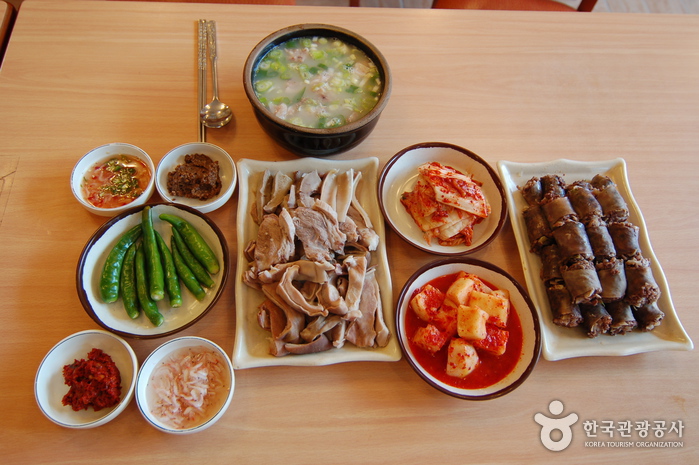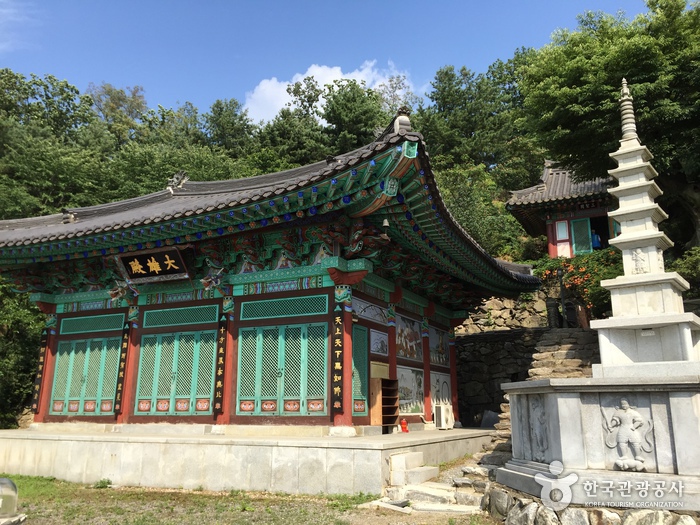Time - Lotte Outlets Gwanggyo Branch [Tax Refund Shop] (롯데아울렛 광교점(타임))
19.1Km 2024-04-23
2F Lotte Outlet Gwanggyo Branch, 10, Docheong-ro, Yeongtong-gu, Suwon-si, Gyeonggi-do
-
Giordano [Tax Refund Shop] (지오다노)
19.1Km 2024-04-19
1F, 10, Docheong-ro, Yeongtong-gu, Suwon-si, Gyeonggi-do
-
Calvin Klein Jean [Tax Refund Shop] (캘빈클라인 진)
19.1Km 2024-04-23
10, Docheong-ro, Yeongtong-gu, Suwon-si, Gyeonggi-do
-
Kolon Ggio2 - Lotte Gwanggyo Branch [Tax Refund Shop] (코오롱 지오투 롯데광교)
19.1Km 2024-04-22
10, Docheong-ro, Yeongtong-gu, Suwon-si, Gyeonggi-do
-
ABC-Mart [Tax Refund Shop] (ABC마트)
19.1Km 2024-06-27
10, Docheong-ro, Yeongtong-gu, Suwon-si, Gyeonggi-do
-
Himart - Gwanggyo Outlet Branch [Tax Refund Shop] (하이마트 광교롯데아울렛)
19.1Km 2024-06-27
10, Docheong-ro, Yeongtong-gu, Suwon-si, Gyeonggi-do
-
Baegam Jeil Sikdang (백암제일식당)
19.1Km 2024-02-29
11 Baegam-ro 201beon-gil, Baegam-myeon, Cheoin-gu, Yongin-si, Gyeonggi-do
+82-31-332-4608
Baegam Jeil Sikdang, located near Dae Jang Geum Park, is renowned for its signature dish, sundae gukbap (blood sausage and rice soup). The experience of enjoying their sundae with kimchi and diced radish kimchi, paired with the thick soup cooked in a cauldron, is delightful. The Baegam sundae, believed to have originated in Baegam-myeon, was developed to satisfy the hunger of people visiting the large cattle market there during the Joseon dynasty. It is known for its chewy texture, abundant vegetables, and pork head meat. Nearby attractions such as Everland, the Korean Folk Village, and the Mulhyanggi Arboretum offer additional experiences to enrich your visit to the area.
San On [Korea Quality] 산온[한국관광 품질인증]
19.3Km 2023-05-23
22-14, Dongmun 3-gil, Yangpyeong-gun, Gyeonggi-do
+82-504-0904-2533
San On is actually two hanok stays, one in Yangpyeong, Gyeonggi-do, the other in Andong, Gyeongsangbuk-do. Yangpyeong San On is nestled among trees and mountains. It has a front yard with scenic views, a side yard for barbecues, and a back yard with a veranda, ideal for taking tea. It’s let out as a single house. The Andong San On (San On : Retreat) stands amid rice fields and has a heated pool. Guests will enjoy walks around the nearby countryside.
Manggyeongam Hermitage (망경암)
19.3Km 2021-04-24
72, Taepyeong-ro 55beon-gil, Sujeong-gu, Seongnam-si, Gyeonggi-do
+82-31-753-3090
Manggyeongam’s name derives from the hermitage's view of Seoul, and is located in Bokjeong-dong of Seongnam, Gyeonggi-do. Manggyeongam
Hermitage is said to be the place where kings of the late Goryeo and early Joseon periods prayed for peace for their subjects. In addition, Prince Pyeongwon, the 7th son of King Sejong, and Grand Prince Jean built an altar at Mangyeongam Hermitage and Chilseongdae Peak and pledged filial piety.
The hermitage is more widely known for its connection to the Chilseong faith, in which believers worship
Chilseong (the Seven Stars). It is easily recognized by the written records inscribed into the rock wall. Located at the hermitage is the Rock-carved Seated Buddha, an original work of the hermitage that is also designated Gyeonggi-do’s Tangible Cultural Asset No. 102. The Buddha is embossed inside a deep hole in the rock. In the words inscribed near the statue, there is also a legend that says Lee Gu-seung carved Gwaneum Statue near Rock-carved Seated Buddha and built the hermitage in 1897.
Next to the hermitage is a pond called “Bokumul,”
which means “blessed sugared water.” The neighborhood of Bojeong-dong takes its name from this pond. At the hermitage, Daeungjeon Hall (the main hall), Samseonggak Shrine (shrine for three spirits), and Mireukjeon Hall were all established fairly recently. The hermitage site also includes a huge Mireuk Daebul statue (Great State of Maitreya Buddha) and a five-story stone pagoda.
Namhansanseong Provincial Park [UNESCO World Heritage] (남한산성도립공원 [유네스코 세계문화유산])
19.3Km 2024-02-29
731 Namhansanseong-ro, Namhansanseong-myeon, Gwangju-si, Gyeonggi-do
+82-31-746-1088
Namhansanseong was a fortress that protected the southern approaches to the capital during the Baekje kingdom (18 B.C. – 660 A.D.) and the Joseon dynasty (1392-1897). During the Qing invasion of Joseon in 1636, King Injo of Joseon (reigned 1623-1649) sought refuge here and constructed Haenggung, a temporary palace. Subsequently, it became the administrative center of the Gwangju region, and today, it is a site where many cultural properties are preserved.

![Calvin Klein Jean [Tax Refund Shop] (캘빈클라인 진)](http://tong.visitkorea.or.kr/cms/resource/02/2882102_image2_1.jpg)
![Kolon Ggio2 - Lotte Gwanggyo Branch [Tax Refund Shop] (코오롱 지오투 롯데광교)](http://tong.visitkorea.or.kr/cms/resource/23/2889023_image2_1.jpg)
![ABC-Mart [Tax Refund Shop] (ABC마트)](http://tong.visitkorea.or.kr/cms/resource/73/3313573_image2_1.jpg)
![Himart - Gwanggyo Outlet Branch [Tax Refund Shop] (하이마트 광교롯데아울렛)](http://tong.visitkorea.or.kr/cms/resource/91/3314691_image2_1.jpg)


![Namhansanseong Provincial Park [UNESCO World Heritage] (남한산성도립공원 [유네스코 세계문화유산])](http://tong.visitkorea.or.kr/cms/resource/56/2612856_image2_1.jpg)
 English
English
 한국어
한국어 日本語
日本語 中文(简体)
中文(简体) Deutsch
Deutsch Français
Français Español
Español Русский
Русский